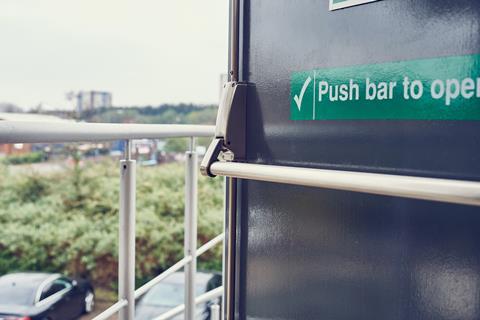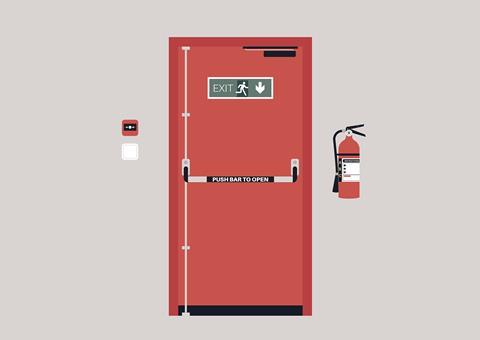Sue Corrick explores the evolution of panic and emergency exit hardware, examining the specification and installation aspects that decision-makers must consider throughout modern application

The swift evacuation of a building and its occupants is critical in an escape or emergency situation. For decades, escape doors and exit hardware have been co-dependent in their purpose of facilitating safe egress when it matters most.
Exit hardware has been providing users with a safe means of escape since the early 20th century. Following a string of high-profile disasters – including the infamous Iroquois Theatre Fire in Chicago in 1903 – the conditions of the world’s built environment and its emergency exits were more closely inspected as crucial elements of public safety. This was in large part due to The National Fire Protection Association’s Life Safety Code.
Incidentally, this period was a catalyst for change in the exit device industry, with the world’s first panic bar made available in an assortment of configurations in 1908, courtesy of Von Duprin.
Today, the term ‘exit hardware’ is more conventionally categorised as either panic hardware or emergency exit hardware. With distinguishing characteristics and features, both categories provide users with a safe means of escape and have come a long way since their inception all those years ago.
As such, selecting the most suitable solution can be a challenge for modern projects and decision-makers are reminded to consider several key factors.

In a fire scenario, a building’s evacuation method must be as straightforward and defined as possible. When a person reaches an exit door, it is essential that the door can be operated with ease, regardless of who is operating it and where it is being used.
While all exit hardware plays an integral role in this process, a building’s type, application and occupation levels must be considered when selecting between panic and emergency exit hardware, since there are meaningful differences between the two.
Panic hardware is a type of exit device that has been designed to provide safe and effective escape through doorways with minimum effort and without prior knowledge of its operation. Devices come in the form of horizontal push or touch bars and are commonly applied to outward opening doors in public facing buildings or buildings with more than 60 occupants, where they can be operated by untrained people or members of the public. As such, panic device push and touch bars should be installed to provide the maximum effective length, but never less than 60% of the door leaf width, as stipulated by BS EN 1125 and harmonised CE and UKCA designated standards.
Due to its size, panic hardware is typically easier to see and operate than some emergency exit hardware devices. With this in mind, panic hardware solutions should be implemented in busy public spaces including hospitals, shops and places of entertainment where usability is paramount. For spaces where the opening width is limited, a non-intrusive touch bar can offer a practical option. Furthermore, in cases where users may wish to gain access from the outside of a door with a panic bar, an outside access device can also be specified to maintain equal levels of accessibility and security.
Emergency exit hardware is dissimilar in a few areas. Typically smaller devices, emergency exit hardware is often applied in buildings with less than 60 occupants or non-public buildings, where its users have prior knowledge of the building’s layout, its escape routes and the exit devices placed throughout them. In design, emergency exit devices commonly comprise a single push pad with a rim latch or a lever handle operating a mortice escape lock or night latch and allow for single-action egress. Where emergency exit hardware is applied, it must be certified to BS EN 179.

As per Approved Document B, all doors located on an escape route must have suitable exit hardware installed. And so, with varied solutions available, specification teams must also consider the door in which an exit device will be fitted. Will the device be applied to single or double doors? What are the height and width requirements? And does the device need anti-thrust bolts for added levels of security? Above all, does it meet the latest fire safety standards?
BS EN 1125 and BS EN 179 standards provide important safety and reliability details on panic hardware and emergency exit devices respectively, reviewing classification, product performance requirements, test cycles and test methods as standard. For traceability purposes, specifiers can also review the UKCA and CE marks on exit hardware to find its fire rating, certificate numbers and the manufacturer’s details.
Dependable devices will be supplied with full product information from the manufacturer – including Declaration of Performance (DoP), Certifire certification and product data sheets – showing that they comply with the necessary harmonised standards. The Code for Construction Product Information has been designed to assist people in reviewing and selecting door hardware solutions transparently and can also be referred to for clear, accurate and up-to-date product information, to ensure door hardware solutions have achieved compliance.
Similarly, when it comes to installation, teams are advised to use the support that’s made available by manufacturers, in the form of online tools and product guides. This further helps to ensure there are no oversights made at the installation stage that could develop into life-threatening issues later down the line. Under current EN standards, it is also recommended that all of a fire door’s hardware devices should be supplied from the same manufacturer and tested together to ensure the full doorset remains compliant in application.
As with all other fire door hardware, there is no one-size-fits-all solution where exit hardware is concerned. Panic hardware and emergency exit hardware play crucial, but separate roles, in a building’s evacuation and as such, both designers and end-users alike must be able to distinguish between them both.
Postscript
Sue Corrick is the product marketing manager at Allegion UK

























No comments yet